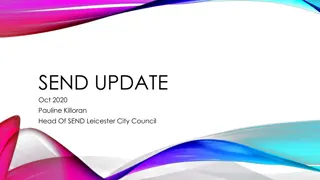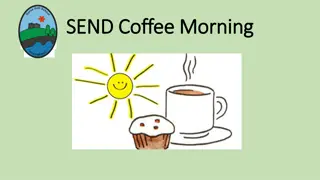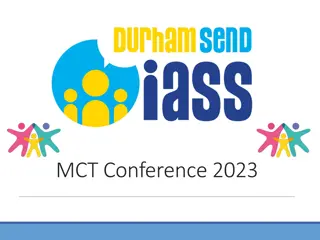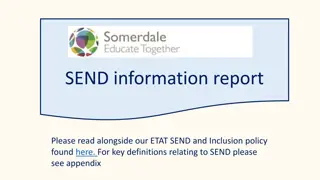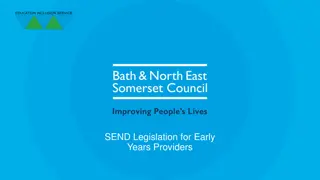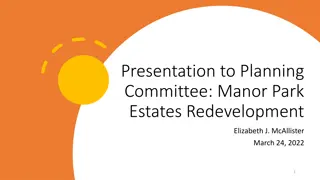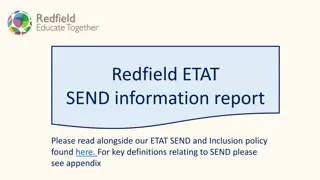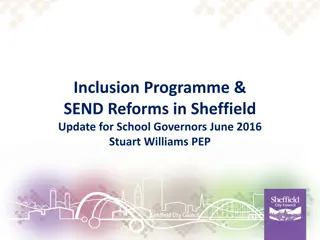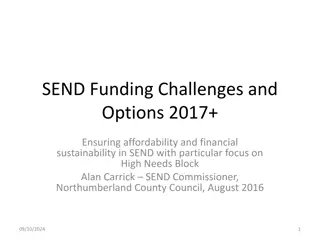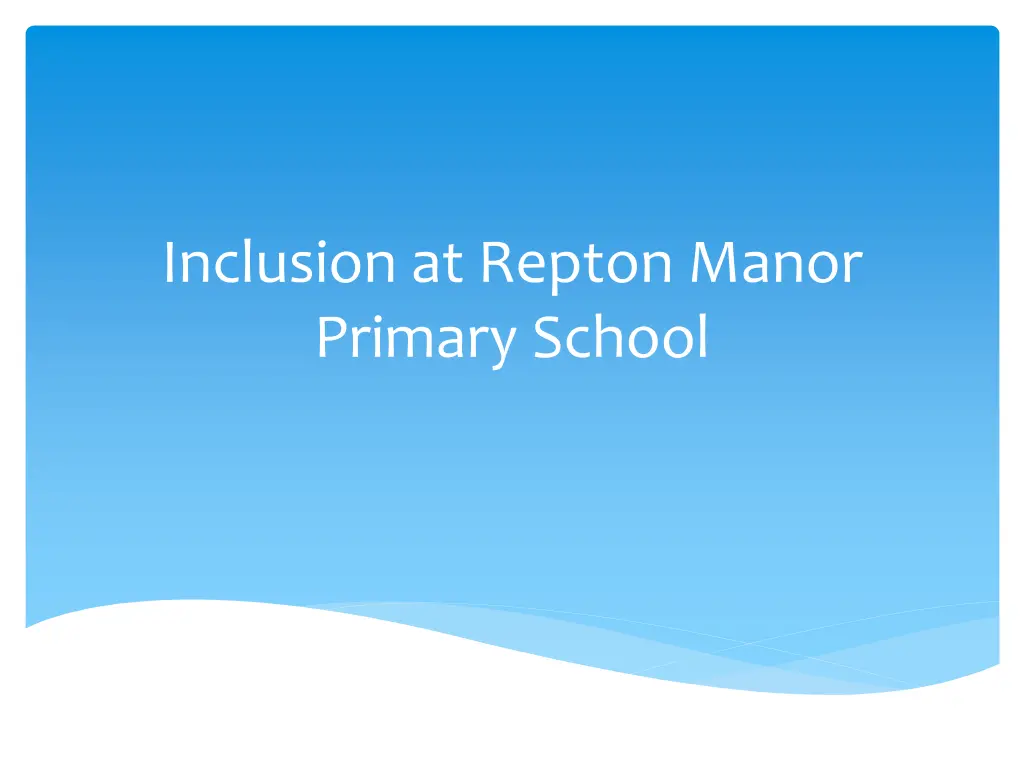
Understanding SEND Profiles at Repton Manor
Discover the SEND profiles at Repton Manor Primary School, including the number of children identified under different categories and support levels. Gain insights into social, emotional, mental health, communication, interaction, cognition, learning, and sensory issues within the school community.
Download Presentation

Please find below an Image/Link to download the presentation.
The content on the website is provided AS IS for your information and personal use only. It may not be sold, licensed, or shared on other websites without obtaining consent from the author. If you encounter any issues during the download, it is possible that the publisher has removed the file from their server.
You are allowed to download the files provided on this website for personal or commercial use, subject to the condition that they are used lawfully. All files are the property of their respective owners.
The content on the website is provided AS IS for your information and personal use only. It may not be sold, licensed, or shared on other websites without obtaining consent from the author.
E N D
Presentation Transcript
Inclusion at Repton Manor Primary School
Aims of the session To have a greater understanding of the SEND Profile for the school. To have an understanding of the Mainstream Core Standards and how they can inform/ develop our daily practice.
Activity 1 You need to be in a group of 5. Person 1 will be the student. Your job is to listen to Person 5 who will be reading an article that you will have to answer questions on. Person 2 stand behind person 1. You need to rub the back of their neck with the piece of card. Do not do this too hard but repeat this action. Person 3 you are to chant the alphabet or the timetables in to Person 1 s ear. You need to do this in a loud voice for the duration. Person 4 pat Person 1 on the head and shoulder repeatedly. Again not too hard! Person 5 - using a normal voice, read a paragraph to Person 1 then ask them questions about what you are reading. DO NOT drown them out the other noises.
SEND Profile at Repton Manor Number of Children identified as SEND (not including Yr R) 65 (13.7%) Term 6 (20-21) 76 chn (15.8%) Number of Children identified as SEN Support 55 (11.6%) Comparison to Kent - 10.5% Comparison to National 12.6% Number of Children with an EHCP 10 children (2.1%) 2 definite applications with a further potential of 2 more. Comparison to Kent - 3.8% Comparison to National 3.3% Number of Children in receipt of HNF 12 children (2.5% of school/ 18.5% of SEND register) 2 definite applications with a further potential of 2 more. Number of Children with Personalised Plans 38 children (8% of school/ 58.5% of SEND register) 1 more set of plans to be written not including Reception.
SEND Profile at Repton Manor % of children identified as Social, Emotional & Mental Health (SEMH) 9 (13.8% of SEND Register 1.9% of School) % of children identified as Communication and Interaction (C& I) 38 children (58.5% of SEND Register 8% of School) % of children identified as Cognition and Learning (C&L) 15 (23% of SEND Register 3% of School) % of children identified as Sensory and/ or Physical (S&P) 3 (4.6% of SEND Register 0.6% of School)
SEND Profile at Repton Manor Communication and Interaction: Speech & Language Therapy 4.8% NHS SALT/ 0.4% Sch SALT Int. NB: Not including the reception children. ASD 3.4% with Diagnosis/ 2.5% awaiting assessment Sensory and/ or Physical: Physical 1.7% Vision 0.2% Medical - 1%
SEND Profile at Repton Manor Social, Emotional and Mental Health: ADHD/ ADD 0% with Diagnosis/ 1.5% awaiting Diagnosis Attachment/ Trauma 0.2% Cognition and Learning: Global Developmental Delay 0.2% Dyslexia 2.1% of chn with diagnosis/ tendencies
Definition of Special Educational Needs and Disability (SEND) Special Educational Needs: A child or young person has SEN if they have a learning difficulty or disability which calls for special educational provision to be made for him or her. A child of compulsory school age or a young person has a learning difficulty or disability if he or she: has a significantly greater difficulty in learning than the majority of others of the same age, or has a disability which prevents or hinders him or her from making use of facilities of a kind generally provided for others of the same age in mainstreams schools. (Special educational needs and disability code of practice: 0-25 years, January 2015, p. 15-16)
Definition of SEN Support The definition of what constitutes SEN Support is less clear. In order to help schools, colleges and Early Years settings accurately identify their SEN Support cohort, KCC provides the following clarification of what constitutes SEN Support: "SEN support is intensive and personalised intervention which is required to enable the child/young person (CYP) to be engaged in learning. It will usually involve significant amounts of resource from the educational setting (approaching, or in a minority of cases exceeding, the nationally prescribed threshold for schools and colleges). Each CYP identified as SEN Support will have Outcomes which have been agreed through a process of collaboration and discussion. A personalised programme of support will be devised and be reviewed and adjusted frequently (at least three times per year) with close CYP and/or parental involvement."
Tiered Approach to SEND Provision Quality First Teaching differentiation based on abilities and starting points, including a range of learning styles. Provision Maps interventions identified and targeted at key areas. Interventions should be tracked and monitored via provision. All intervention should follow the graduated approach. Pupils Raised to Phase Leaders, PINC team or via Class Tutorials. Consider next steps and discussing if child needs to be identified as having Special Educational Needs and/ or disability. Personalised Plans with identified long term outcomes agreed with parents reviewed a minimum of 3 times a year. Ensuring best endeavours and the graduated approach is being implemented.
Tiered Approach to SEND Provision (cont) Access to outside agencies if appropriate LIFT, Educational/ Clinical Psychology, OT, SALT etc. If the provision identified for a child as part of their personalised plan exceeds 6000, we would consider an application for High Needs Funding (HNF). Application for Statutory Assessment (EHCP) - If still requiring high levels of support with provision plans and HNF in place and making limited to no progress.
ACTIVITY 2 No Words In groups of 5. Using a slip of paper write a simple message on the paper. Swap your message with another member of your group. Take it in turns to communicate the message to the rest of the group without writing, speaking or using any letters of the alphabet.
Introducing the New Mainstream Core Standards (MSC) The Mainstream Core Standards Guide for schools and parents can be found on our school website or by following the link below. https://www.kelsi.org.uk/special-education- needs/special-educational-needs/the- mainstream-core-standards
Mainstream Core Standards The Mainstream Core Standards is divided in two sections: Section 1 Expectations of all schools. This section outlines the expectations on all schools, according to the needs of the child/ young person. Section 2 Additional Support. Some learners with SEND will require more support than most peers. This support will be provided in addition to the support in section 1.
The purpose of the MSC. Outlines the provision that the local area expects to be made available for children and young people with SEND attending mainstream schools. It is a universal document, to support mainstream practitioners, aid local conversations and promote a consistent high-quality approach to SEND inclusion. Details a range of exemplar strategies and interventions that schools may adopt for each need type.
Section 1 Expectations of the School This section outlines the expectations on all schools, according to the needs of the child/young person. Broadly speaking much of this section will be an integral part of the school s provision for all children. It outlines some of the practices and adaptations that are part and parcel of Quality First Teaching (QFT): the inclusion of all pupils in high-quality everyday personalised teaching. The provision and strategies outlined in this section may be required for children and young people with SEN and/or disabilities but will undoubtedly be of benefit to many of the learners in the school.
Legal Duties of Schools in regards to SEND The law is underpinned by the principle that where a parent of a child with SEN, or a young person with SEN, wants a place in a mainstream setting, they must not be denied it on the basis that mainstream education is unsuitable, or that their needs or disabilities are too great or complex.
Legal Duties of Schools in regards to SEND Schools have clear duties in regard to the support of children and young people with special educational needs ( SEN ) and/or disabilities under the Children and Families Act 2014 and SEN and Disability Code of Practice 2015 (the Code ). Schools must have regard to the Code. This means that they should do what it says or be able to explain why they have not done so, and what alternative action has been taken. Mainstream schools must ensure that children or young people with SEN engage in the activities of the school together with children or young people who do not have special educational needs (section 35 of the Children and Families Act 2014).
The Best Endeavours Duty The Best Endeavours Duty: One of the key duties is for the school to use their best endeavours to support children and young people with SEN. (This applies to mainstream and alternative provision settings.) This means doing everything that could reasonably be expected of them. The law says: If a registered pupil or a student at a school or other institution has special educational needs, the appropriate authority must, in exercising its functions in relation to the school or other institution, use its best endeavours to secure that the special educational provision called for by the pupil s or student s special educational needs is made. (Section 66 of the Children and Families Act 2014)
The Best Endeavours Duty These duties apply to all children and young people with SEN whether they have an EHC plan or not. Using best endeavours means doing everything they can to meet the child or young person s SEN. It is a duty that requires the appropriate authority to enquire and ensure that the school is actually making the special educational provision that children and young people require. The best endeavours duty requires schools to consider obtaining specialist help, such as a speech and language therapist or educational psychologist: where a pupil continues to make less than expected progress, despite evidence based support and interventions that are matched to the pupil s area of need, the school should consider involving specialists, including those secured by the school itself or from outside agencies. (SEND CoP paragraph 6.58 for schools)
Working with children and young people, their families and carers Read pages 5-15 RAG rating. Green we are doing this and we are good at it. Amber we are on our way to achieving this. Red we are not doing this. NB: SEND Information report is the SEND Policy
ACTIVITY 3 Instructions In groups of 5 each person will need a piece of paper and a pen. 1 person to draw a picture on their sheet of paper (hidden from the rest of the group) whilst drawing the picture describe what you are drawing. The rest of the group to draw the picture. Compare pictures once the task is complete
Section 2 Additional Support Some learners with SEND will require more support than most of their peers. This support will be provided in addition to the support set out in Section One. Usually, when a learner is receiving this additional support, they will have an identified special educational need or disability or be presenting with characteristics that fall under one of the four broad areas of need set out in SEND Code of Practice 2015.
Four Broad Areas of Need: Communication and Interaction (C&I) -Speech, language and communication needs characteristics of aspects of Autism Spectrum (ASD/ ASC). (SLCN) and Autism or Cognition and Learning (C&L) difficulties (SpLD) Dyspraxia, as well as moderate learning difficulties (MLD), severe learning difficulties (SLD) and profound and multiple learning difficulties (PMLD). specific learning Dyscalculia such as Dylsexia, and
Four Broad Areas of Need (cont.) Social, Emotional and Mental Health Difficulties (SEMH) social and emotional difficulties which manifest in many ways. Some children may have disorders such as; attention deficit disorder (ADD), attention deficit hyperactivity disorder (ADHD), ODD, Anxiety, depression, OCD or attachment disorder etc. Sensory and/ or Physical Needs (S&P) a child may have a disability that may prevent or hinder them making use of the educational facilities generally provided. Some children may have a visual impairment (VI), a hearing impairment (HI) or a multi-sensory impairment (MSI). Some children may have a physical disability (PD).
The Assess, Plan, Do, Review Cycle (APDR) and the Graduated Approach 3 I s: Intent, Implement & Impact APDR strategies and interventions that are regularly monitored, reviewed and evaluated to inform next steps. Graduated Approach an understanding of what is needed and what works best for a child, which can result in more support being put in place to ensure they are included and are making progress across the curriculum.
The Assess, Plan, Do, Review Cycle (APDR) and the Graduated Approach cont Provision is put in place in response to current presenting, underlying or emerging need and is not dependent on a child or young person receiving a formal diagnosis of a specific condition or disability. Children and young people with EHCPs will receive provision to meet their needs as described in Sections One and Two, alongside the additional provision set out in Section F of their plan. (Section F is a legal requirement) Children, young people and their families are the experts on the impact of their condition or disability. They often already know what helps when they re in school (and what doesn t) and will be able to share with you what helps when at home or out and about. Collaborative working with children, young people and their families is the starting point when planning, implementing and reviewing SEND provision.
Each Section has a What you will see and What can Help section.
Case Studies Activities Using section 2 of the Mainstream Core Standards can you identify some strategies/ intervention to form a proposed provision action plan for a child. NB: Remember the 3 I s/ Plan, Do, Review and Assess process sometimes less is more. How will you know which interventions are having impact?
Acronyms SEND Special Educational Needs and/ or Disability EHCP Educational Health Care Plan HNF High Needs Funding. P/ Plans Personalised Plans SALT Speech and Language Therapy OT - Occupational Therapy LIFT Local Inclusion Forum Team STLS Specialist Teaching and Learning Service EP Educational Psychology MSC Mainstream Core Standards
Acronyms CAMHS Children and Adults Mental Health Services ASD/ ASC Autism Spectrum Disorder/ Condition ADHD Attention Deficit/ Hyperactivity Disorder ADD Attention Deficit Disorder ODD Oppositional Defiance Disorder OCD Obsessive-compulsive Disorder MLD Moderate Learning Difficulty DCD Developmental Co-ordination Disorder




